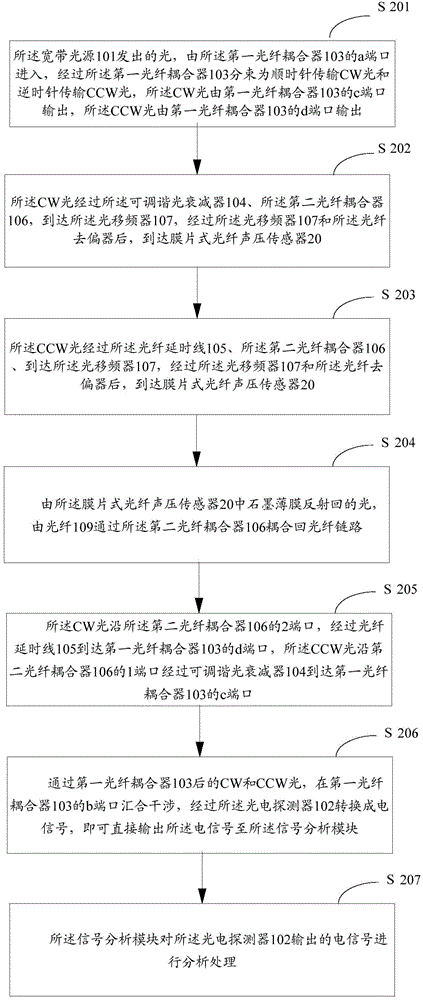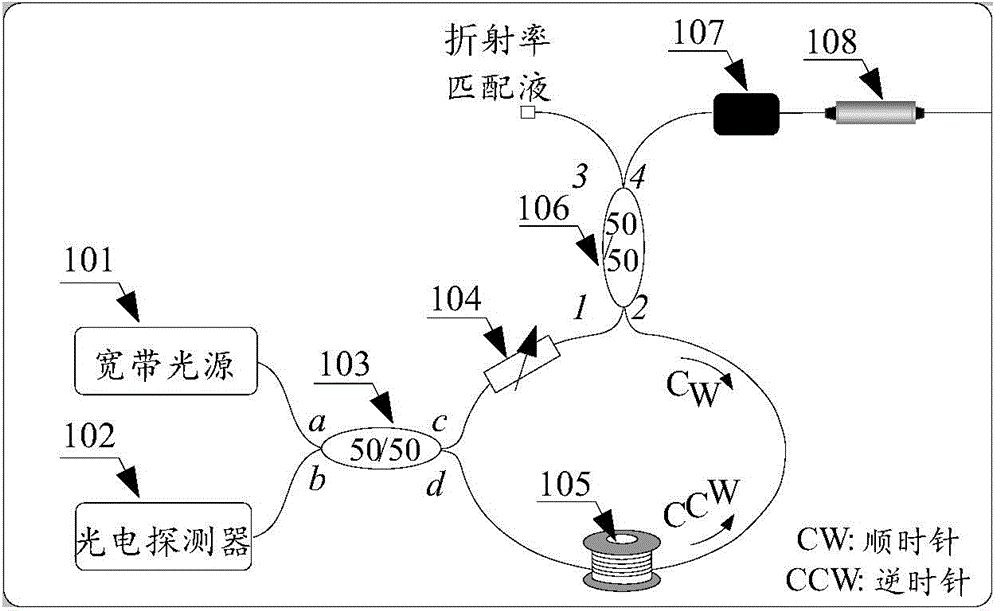Phase demodulator, optical fiber sound pressure demodulation system, demodulation method and manufacturing method
A technology of phase demodulator and demodulation system, which is applied in the field of sound pressure measurement devices, achieves the effects of high stability, simple structure, and reduced complexity and difficulty
- Summary
- Abstract
- Description
- Claims
- Application Information
AI Technical Summary
Problems solved by technology
Method used
Image
Examples
Embodiment 1
[0038] figure 1 It is a structural block diagram of the phase demodulator 10 provided by the embodiment of the present invention, and is described in detail as follows:
[0039] A kind of phase demodulator 10, adopts the structure of Sagnac fiber optic ring, external diaphragm type optical fiber sound pressure sensor 20, comprises broadband light source 101, photodetector 102, connects described photodetector 102, receives described photodetector 102 The electrical signal of output and the signal analysis module of demodulation, it is characterized in that, described phase demodulator 10 also comprises:
[0040] respectively connecting the broadband light source 101 and the photodetector 102, and splitting the light emitted by the broadband light source 101 into a first optical fiber coupler 103 for clockwise transmission of CW light and counterclockwise transmission of CCW light;
[0041] Connect the first optical fiber coupler 103 to adjust the intensity of the CW light, or...
Embodiment 2
[0083] image 3 It is a better structural diagram of the phase demodulator 10 provided by the embodiment of the present invention, and is described in detail as follows:
[0084] The a port of the first optical fiber coupler 103 is connected to the broadband light source 101, the b port is connected to the photodetector 102, the c port is connected to the first end of the optical fiber delay line 104, and the d port is connected to the tunable optical a first end of the attenuator 105;
[0085] Port 1 of the second fiber coupler 106 is connected to the second end of the fiber delay line 104, port 2 is connected to the second end of the tunable optical attenuator 105, and port 3 is an idle end for antireflection light processing , 4 ports connected to the first end of the optical fiber frequency shifter;
[0086] The second end of the optical fiber frequency shifter is connected to the first end of the optical fiber depolarizer 108 , and the second end of the optical fiber de...
Embodiment 3
[0091] Figure 4 It is a structural block diagram of an optical fiber sound pressure demodulation system provided by an embodiment of the present invention, and is described in detail as follows:
[0092] An optical fiber is used to connect the phase demodulator 10 and the graphene diaphragm-based diaphragm fiber optic acoustic pressure sensor 20 .
[0093] Wherein, the diaphragm-type optical fiber sound pressure sensor 20 is connected to the phase demodulator 10 by an optical fiber, and reflects light through a graphene diaphragm.
[0094] Figure 5 It is a schematic structural diagram of an optical fiber acoustic pressure demodulation system provided by an embodiment of the present invention.
[0095] Figure 6It is an implementation flowchart of a demodulation method based on an optical fiber sound pressure demodulation system provided by an embodiment of the present invention, and is described in detail as follows:
[0096] S601, connecting the diaphragm-type optical f...
PUM
 Login to View More
Login to View More Abstract
Description
Claims
Application Information
 Login to View More
Login to View More - R&D
- Intellectual Property
- Life Sciences
- Materials
- Tech Scout
- Unparalleled Data Quality
- Higher Quality Content
- 60% Fewer Hallucinations
Browse by: Latest US Patents, China's latest patents, Technical Efficacy Thesaurus, Application Domain, Technology Topic, Popular Technical Reports.
© 2025 PatSnap. All rights reserved.Legal|Privacy policy|Modern Slavery Act Transparency Statement|Sitemap|About US| Contact US: help@patsnap.com



